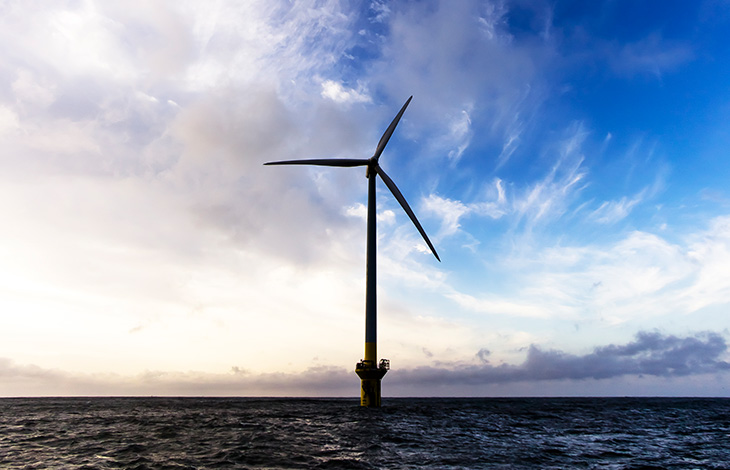Carbon Neutrality
Management Approach
The TEPCO Group, as members of the Electric Power Council for a Low-Carbon Society (ELCS)*, promotes low-carbonization of energy to achieve our voluntary goals, by such efforts as improvement of expansion of renewable energy.
- *
Participation of 65 Japanese power operators in Japan (as of June 18, 2021), including the TEPCO Group
We will develop strategies for climate change, taking into consideration of the condition of restart of nuclear power, which greatly contributes to CO2 reduction.
Major Initiatives
| Segment | Details |
|---|---|
| Power generation | Installation of renewable energy power generation |
| Power distribution | System development towards expanding renewable energy installation, promoting installation of smart meters |
| Retail | Reducing CO2 emissions of electricity delivered to the customers by 50% or more by fiscal 2030 compared to in fiscal 2013, that is related to Scope 3 emissions |
[Voluntary Goals by the Electric Power Council for a Low Carbon Society (ELCS)]
Goals premising of realization of Japan's FY2030 energy mix
(prospect of long-term energy supply and demand)
| FY2020 | FY2030 | FY2018 actual | |
|---|---|---|---|
| Emission intensity (end use) | - | Approx. 0.37kg-CO2/kWh | 0.531kg-CO2/kWh |
| Maximum reduction potential by adopting BAT during installation of new thermal power plants | Approx. 7 million t-CO2 | Approx. 11 million t-CO2 | Approx. 8.5 million t-CO2 |
Targets and Initiatives for Carbon Neutrality
TEPCO* has grasped the global trend of decarbonization and is boldly shifting to a business model based on carbon neutrality.
FY2030 target :
Reduce CO2 emissions of electricity delivered to customers by 50% in FY2030 compared to FY2013
2050 challenge :
Reduce CO2 emissions from the supply of energy to net zero by 2050
With these objectives in mind the entire Group is engaged in initiatives to both develop zero-emission power sources and further promote the electrification of energy demand so that we can work with society to achieve carbon neutrality.
- *
Refers to the five companies. Tokyo Electric Power Company Holdings, Inc., TEPCO Fuel & Power, Inc., TEPCO Power Grid, Inc., TEPCO Energy Partner, Inc., TEPCO Renewable Power, Inc.
[Society] Achieving Carbon Neutrality with Our Customers
Initiatives on the energy demand side, such as developing emission-free power sources and replacing fossil fuels with "electrification," etc., are important for achieving carbon neutrality.
TEPCO is working with our customers to improve energy resilience during emergencies, live more comfortably, and achieve carbon neutrality.

[Grids] Smart Systems for Supporting Carbon Neutrality
Transmission and distribution networks play an important role in the introduction of large amounts of renewable energy. And, they need to be more resilient to natural disasters which are becoming fiercer and affecting larger areas.
In order to achieve carbon neutrality and strengthen the resilience of power grids, we will leverage digital technology to increase the value of regionally dispersed energy, and make changes to both equipment and facility configuration in order to more effectively utilize dispersed transmission and distribution networks.

[Supply] The Best Mix for Carbon Neutrality
Zero-emission power sources are needed if we are going to achieve carbon neutrality. However, in Japan, which has few natural resources, it is important to balance energy security with economic efficiency while prioritizing safety. As an energy provider, TEPCO is aiming for a best mix of energy in order to achieve carbon neutrality that is based on the S+3E's.

Energy Consumption within the Organization <GRI302-1, 302-4>
TEPCO Group energy consumption were as shown below.
Fuel Consumption
| Unit | FY2018 | FY2019 | FY2020 | FY2021 | |
|---|---|---|---|---|---|
| Coal | kt | 8,145 | <1 | <1 | <1 |
| Heavy oil, crude oil, etc. | ML | 558 | 44 | 44 | 43 |
| Gas (LNG, LPG) | kt | 20,785 | <1 | <1 | <1 |
| City gas | mil m3 | 2,090 | <1 | <1 | <1 |
| Fuel for nuclear power plants | t | 0 | 0 | 0 | 0 |
| Biomass | kt | 200 | 0 | 0 | 0 |
Energy Consumption
| Unit | FY2018 | FY2019 | FY2020 | FY2021 | |
|---|---|---|---|---|---|
| Total | GJ | 1,471,624,333 | 12,574,384 | 12,376,989 | 12,283,582 |
Energy Intensity <GRI302-3>
Energy Consumption Intensity in Buildings
| Unit | FY2018 | FY2019 | FY2020 | FY2021 | |
|---|---|---|---|---|---|
| Per total floor space of office (headquarters, branch offices, etc.) | MJ/m2 | 1,410 | 1,407 | 1,397 | 1,336 |
- *
Energy consumption intensity = office building energy consumption (MJ) / surface area of that office building (m2)
- *
Energy included in intensity is fuel, electricity, heating, and cooling.
Reductions in Energy Requirements of Sold Products and Services Achieved <GRI302-5>
Due to the characteristics of our business, the products and services we provide do not require energy consumption. Thus, there are no changes in energy requirements.
GHG Emissions and Energy Consumption within the Organization
Direct Greenhouse Gas Emissions (Scope 1) <GRI305-1>
| Unit | FY2018 | FY2019 | FY2020 | FY2021 | |
|---|---|---|---|---|---|
| Scope 1 emissions | kt-CO2 | 81,604 | 191 | 190 | 192 |
- *
CO2 emissions are due to the consumption of fuel used for power generation at the TEPCO Group's thermal power plants.
- *
No CO2 emissions from bio-fuel
Other CO2eq Emissions <GRI305-1>
| Unit | FY2018 | FY2019 | FY2020 | FY2021 | |
|---|---|---|---|---|---|
| CH4 (Methane) | kt-CO2 | 0 | 0 | 0 | 0 |
| N2O (Dinitrogen monoxide) | kt-CO2 | 59 | 1 | 1 | 1 |
| HFCs | kt-CO2 | 6 | 3 | 3 | 3 |
| PFCs | kt-CO2 | 0 | 0 | 0 | 0 |
| SF6 (Sulfur hexafluoride) | kt-CO2 | 61 | 59 | 59 | 63 |
| NF3 | kt-CO2 | 0 | 0 | 0 | 0 |
- *
No CO2 emissions from bio-fuel.
- *
We selected the stock equity method as the consolidation approach for the calculation of emissions.
- *
As a reference for calculation, we used the "System for Calculating, Reporting, and Publishing Greenhouse Gas Emissions" based on the Act on Promoting Global Warming Countermeasures.
Indirect Greenhouse Gas Emissions (Scope 2) <GRI305-2>
CO2 Emissions Due to the Use of Electricity, Heat and Steam Supplied by Others (Location Based)
| Unit | FY2018 | FY2019 | FY2020 | FY2021 | |
|---|---|---|---|---|---|
| CO2 emissions | kt-CO2 | 564 | 5,892 | 5,207 | 6,097 |
- *
Location based means reflecting the average emissions intensity of grids.
- *
We selected the stock equity method as the consolidation approach for the calculation of emissions.
GHG Emissions and Energy Consumption outside of the Organization <GRI 302-2, 305-3>
Other Indirect Greenhouse Gas Emissions (Scope 3, per GHG Protcol)
Due to the characteristics of our products and services and the nature of our business, energy consumption is zero for (4) Transportation & Distribution (Upstream),(8) Leased Assets (Upstream), (9) Transportation & Distribution (Downstream), (10) Processing of Sold Products, (12) End-of-Life Treatment of Sold Products, (13) Leased Assets (Downstream), (14) Franchises and (15) Investments
| Scope 3 Emissions Category | Unit | FY2018 | FY2019 | FY2020 | FY2021 | |
|---|---|---|---|---|---|---|
| Upstream | (1) Purchased Goods & Services | kt-CO2 | 1,096 | 1,342 | 1,236 | 1,670 |
| (2) Capital Goods | kt-CO2 | 2,034 | 1,664 | 1,906 | 1,779 | |
| (3) Fuel- and Energy- Related Activities Not Included in Scope 1 or 2 | kt-CO2 | 34,387 | 112,535 | 101,402 | 91,342 | |
| (4) Transportation & Distribution (Upstream) | kt-CO2 | 0 | 0 | 0 | 0 | |
| (5) Waste Generated in Operations | kt-CO2 | 30 | 2 | 2 | 3 | |
| (6) Business Travel | kt-CO2 | 4 | 4 | 4 | 4 | |
| (7) Employee Commuting | kt-CO2 | 11 | 11 | 11 | 10 | |
| (8) Leased Assets (Upstream) | kt-CO2 | 0 | 0 | 0 | 0 | |
| Downstream | (9) Transportation & Distribution (Downstream) | kt-CO2 | 0 | 0 | 0 | 0 |
| (10) Processing of Sold Products | kt-CO2 | 0 | 0 | 0 | 0 | |
| (11) Use of Sold Products | kt-CO2 | 4,793 | 5,888 | 5,559 | 7,329 | |
| (12) End-of-Life Treatment of Sold Products | kt-CO2 | 0 | 0 | 0 | 0 | |
| (13) Leased Assets (Downstream) | kt-CO2 | 0 | 0 | 0 | 0 | |
| (14) Franchises | kt-CO2 | 0 | 0 | 0 | 0 | |
| (15) Investments | kt-CO2 | 0 | 0 | 0 | 0 | |
| Total | kt-CO2 | 42,355 | 121,446 | 110,119 | 102,137 | |
Note
Approach to calculation
We follow major guidelines have been published:
“Corporate Value Chain (Scope 3) Accounting and Reporting Standard”
“Green Value Chain Platform (Japanese Ministry of the Environment website, which provides Scope 3 emissions calculation methods and models)”
Calculation Method for Each of the Categories
| Category 1: | Calculated by multiplying the amount of purchased goods by the emission factor |
| Category 2: | Calculated by multiplying the amount of annual capital investment in financial report by the emission factor |
| Category 3: | The sum of the following two values;
|
| Category 4: | No applicable emissions due to our type of business |
| Category 5: | Calculated by multiplying the volume of industrial waste by the emission factor for each type of waste treatment method |
| Category 6: | Calculated by multiplying the number of employees by the emission factor |
| Category 7: | Calculated by multiplying the number of employees by the number of business days and the emission factor for each location type of office |
| Category 8: | No applicable emissions due to our type of business |
| Category 9: | No applicable emissions due to our type of business |
| Category 10: | No applicable emissions due to our type of business |
| Category 11: | Calculated by multiplying the volume of gas sales by the emission factor |
| Category 12: | No applicable emissions due to our type of business |
| Category 13: | No applicable emissions due to our type of business |
| Category 14: | No applicable emissions due to our type of business |
| Category 15: | No applicable emissions due to our type of business |



















